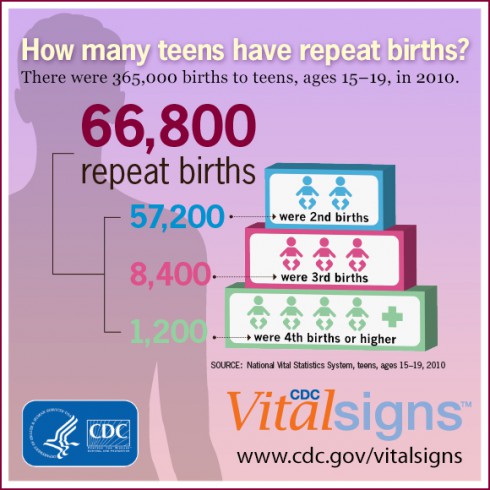REPORT One in five babies born to teen moms have older siblings
Researchers announced this week that more than 18 percent of teenage mothers delivered their second, third or fourth child in 2010.
Although teenage pregnancy rates have declined in recent years, this latest statistic is bad news for the researchers at the Centers for Disease Control and Prevention (CDC). Latter babies for teen mothers are proven to have lower average birth weights. A greater number are also born preterm, which puts them at greater risks for health complications.
Multiple births also place a strain on the young mothers.
“Repeat births can negatively impact the mother’s education and job opportunities,” said Dr. Tom Frieden, director of the CDC.
For the study, researchers analyzed data from the National Vital Statistics System and the Pregnancy Risk Assessment Monitoring System. They discovered that 18.3 percent of the 365,000 births to mothers aged 15-19 were repeat births. Although 85 percent of the repeat births were to second children, more than 12 percent were to third children and 1.7 percent were to fourth, fifth or sixth children.
The level of repeat pregnancies indicates that many teenagers are not very informed about birth control — even if they’ve gotten pregnant before. The CDC discovered that just 22 percent of teen moms used the most effective birth control methods after their first pregnancies. An alarming 8.8 percent didn’t use any method of pregnancy prevention.
“The best way to prevent teen pregnancy across the board is by investing in effective sex education, encouraging teens to talk to their parents, and ensuring access to birth control,” said Leslie Kantor of the Planned Parenthood Federation of America.
The study also found that states with the lowest rates of health insurance coverage have the highest rates of teenage pregnancy. That may be because young women don’t think they can afford birth control.
“Overall, this data clearly speaks to the importance of the Affordable Care Act – which provides funding for teen pregnancy prevention programs and gives women coverage without co-pay for the full range of FDA-approved contraceptive methods,” Kantor said.
Repeat birth rates were also higher among ethnic minorities. American Indian/Alaska Natives had a 21.6 percent incident of repeat births, Hispanics had a 20.9 percent incident and non-Hispanic blacks had 20.4 percent incident. With 14.8 percent, non-Hispanic whites had the lowest rate of repeat births.



